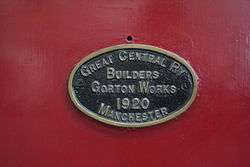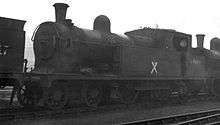Gorton Locomotive Works

Gorton Locomotive Works, known locally as Gorton Tank, was in Openshaw near Manchester, England and was completed in 1848 by the Sheffield, Ashton-under-Lyne and Manchester Railway. Even in the 1960s the number of men who worked there was large enough to support nine public houses in the nearby Ogden Lane.
History
The original workshops of the Sheffield, Ashton-under-Lyne and Manchester Railway were in Newton near Hyde in Cheshire but were inconveniently situated, cramped and makeshift. In 1845 the railway asked their locomotive superintendent, Richard Peacock, to find a more suitable site for a locomotive and carriage and wagon works. The site selected was two and a half miles east of Manchester at the side of the railway line between the Manchester to Guide Bridge. Peacock was responsible for the planning and design of the works, which at the time of completion covered about 20 acres (81,000 m2), and eventually growing to 30 acres (120,000 m2). By the time the works were completed in 1848 the railway had become the Manchester, Sheffield & Lincolnshire Railway.
The original motive power depot at Gorton, in the form of a roundhouse was unique in that it had two roads instead of the customary one with a pillar in the centre supporting the glazed roof. It was later replaced by a larger facility but was converted to a smithy. The locomotive workshops were adjacent to the roundhouse on its Western side, with the carriage and wagon shops and a paint shop on the other side of the loco shops. A reservoir was constructed adjacent to the nearby Ashton Canal.
Richard Peacock left the Manchester, Sheffield & Lincolnshire Railway in 1854 and with Charles Beyer founded the Beyer Peacock locomotive company at Gorton Foundry directly opposite Gorton Works on the Southern side of the railway line. He was replaced by William Grindley Craig, who served until 1859, and thence by Charles Sacré until 1886. Between 1871 and 1880 the works was unable to keep pace with new construction and repairs and so Gorton manufactured new parts for locomotives that were constructed or renewed at the Sheffield running shed.[1]
In 1880 Sacré's Carriage and Wagon Superintendent, Thomas Parker oversaw the construction of new Carriage and wagon shops on the site thereby enabling the original shops to be converted into a new enlarged Erecting shop the following year. Following Sacré's retirement and suicide in 1889, Parker took over as Locomotive Superintendent until his own retirement in 1893. He was responsible for the construction of a new machine shop and stores in 1889, and the enlargement of the motive power depot to accommodate 120 locomotives.[2]
Parker was replaced by Harry Pollitt who served until 1900. During this time the Manchester, Sheffield & Lincolnshire Railway changed its name to the Great Central Railway following the opening of its London extension to Marylebone station. Pollitt was superseded by John G. Robinson, as locomotive and marine superintendent in 1900 and who was appointed chief mechanical engineer in 1902.
Under Robinson, new erecting shops were built, and the old erecting shop (the original Carriage and Wagon shops) were converted into machine and fitting shops, and the construction of a new carriage and wagon works at Dukinfield in 1910 enabled additional locomotive work to be carried out in the former carriage and wagon shops.
Grouping and Nationalisation

Following the merger of the Great Central Railway and other railways in eastern England and Scotland to form the London and North Eastern Railway, as a result of the Railways Act grouping of 1923, most new locomotive design and construction moved to the larger facilities at Doncaster and Darlington Works. Between the 1930s and late 1950s, Gorton works mainly concentrated on the repair and modification of locomotives and the manufacture of parts. Locos were handled from all over the LNER system. British Railways scrapped many locomotives here during the run down of steam in the 1950s and early 1960s during the Beeching era.
Closure
The railway works were closed 31 May 1963 following a re-organisation of railway workshops and the work was transferred to Doncaster.[1] The motive power depot was closed in 1965. A wholesale fruit and veg market (New Smithfield Market), a police motor vehicle garage and a cash and carry warehouse now stand on the site.
Locomotive construction at Gorton


Locomotive building began at Gorton under Craig in 1858 with the completion of 0-6-0 No. 6 Archimedes. Over the next sixty years the works constructed many of the MS & LR and GCR locomotives including Parker and Sacre 2-4-0 and 0-6-0 freight classes and several of the Robinson 4-6-0 and 4-4-0 express passenger and mixed traffic classes. The 500th locomotive was GCR Class 11A (LNER Class D6) 4-4-0 No.858.[1]
From 1911, the works constructed 130 of Robinson's GCR Class 8K (later O4) 2-8-0 heavy freight locomotives. During the First World War the design was adopted by the War Department's Railway Operating Division (ROD) for use in continental Europe. Six of the ROD 2-8-0s were built at Gorton in 1918 and 1919, with the remainder of the 521 engines being built by private locomotive manufacturers including 369 from the North British Locomotive Company in Glasgow.[3]
By the end of Great Central Railway ownership in December 1922, 921 steam locomotives had been built at Gorton. This figure had reached 1006 by 1951, when the last steam locomotive, a LNER Thompson Class B1 4-6-0 61349 was completed.[4]
Following the nationalisation of British Railways (BR) in 1948, Gorton was used for the construction of sixty four electric locomotives of Class 76 and Class 77, between 1950 and 1954, which were required for the newly electrified Woodhead Line from Manchester London Road to Sheffield Victoria.
References
- Gosling, Dave (2005) Gorton Locomotive Works Openshaw Manchester, http://gorton-tank.com/
- Rowledge, J.W.P., (1977) Heavy Goods Engines of the War Department - Volume 1 - ROD 2-8-0, Springmead Railway Books.
- Railway Correspondence and Travel Society, (1963) Locomotives of the L.N.E.R. Part 1., R.C.T.S.
- Larkin, E.J. and Larkin, J.G. (1988) The Railway Workshops of Great Britain 1823–1986, London : Macmillan, 266 p., ISBN 0-333-39431-3
Coordinates: 53°28′13″N 2°10′20″W / 53.4704°N 2.1723°W
